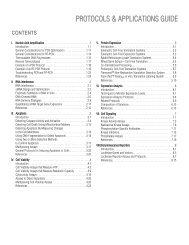2012 Promega catalogue
2012 Promega catalogue
2012 Promega catalogue
Create successful ePaper yourself
Turn your PDF publications into a flip-book with our unique Google optimized e-Paper software.
Life<br />
Science<br />
Catalog<br />
<strong>2012</strong><br />
Worldwide Contact List<br />
Section<br />
Contents<br />
Table of<br />
Contents<br />
Cell Signaling<br />
Protein Labeling and Detection<br />
234<br />
HaloTag ® Fluorescent Ligands<br />
Product Size Conc. Cat.# Price ($)<br />
HaloTag ® TMR Ligand 30 µl 5 mM G8251 904.00<br />
15 µl 5 mM G8252 504.00<br />
HaloTag ® Oregon Green ® Ligand 30 µl 1 mM G2801 904.00<br />
15 µl 1 mM G2802 504.00<br />
HaloTag ® diAcFAM Ligand 30 µl 1 mM G8272 904.00<br />
15 µl 1 mM G8273 504.00<br />
HaloTag ® Coumarin Ligand 30 µl 10 mM G8581 904.00<br />
15 µl 10 mM G8582 504.00<br />
HaloTag ® Alexa Fluor ® 488 Ligand 30 µl 1 mM G1001 904.00<br />
15 µl 1 mM G1002 504.00<br />
HaloTag ® TMRDirect Ligand 30 µl 0.1 mM G2991 521.00<br />
HaloTag ® R110Direct Ligand 30 µl 0.1 mM G3221 521.00<br />
HaloTag ® Biotin Ligand 30 µl 5 mM G8281 904.00<br />
15 µl 5 mM G8282 504.00<br />
HaloTag ® PEG-Biotin Ligand 30 µl 5 mM G8591 904.00<br />
For Research Use Only. Not for Use in Diagnostic Procedures.<br />
15 µl 5 mM G8592 504.00<br />
Description: The HaloTag ® Fluorescent Ligands can carry a variety of functionalities,<br />
including fluorescent labels, affinity tags and attachments to a solid<br />
phase. The covalent bond forms rapidly under general physiological conditions,<br />
is highly specific and essentially irreversible. The HaloTag ® Fluorescent Ligands<br />
allow researchers to apply the chloroalkane group that HaloTag ® protein reacts<br />
with to any compound or surface with a compatible chemical group, creating<br />
endless possible applications.<br />
HaloTag ® Fluorescent Ligands for Cellular Imaging<br />
Cell-permeant fluorescent ligands (rapid labeling protocol):<br />
• HaloTag ® TMR Ligand (555 Ex/585 Em)<br />
• HaloTag ® Oregon Green ® Ligand (496 Ex/516 Em)<br />
• HaloTag ® diAcFAM Ligand (494 Ex/526 Em)<br />
• HaloTag ® Coumarin Ligand (353 Ex/434 Em)<br />
Cell-impermeant fluorescent ligands for cell-surface labeling (rapid labeling<br />
protocol):<br />
• HaloTag ® Alexa Fluor ® 488 Ligand (494 Ex/517 Em)<br />
Cell-permeant fluorescent ligands (“no wash” protocol):<br />
• HaloTag ® TMRDirect Ligand (555 Ex/585 Em)<br />
• HaloTag ® R110Direct Ligand (502 Ex/527 Em)<br />
The Alexa Fluor ® 488 Ligand is impermeable to cell membranes and, therefore,<br />
used to label cell surface proteins. The TMR Ligand, Oregon Green ® Ligand,<br />
diAcFAM Ligand and Coumarin Ligand readily cross the cell membrane and,<br />
therefore, can be used to label intracellular proteins.<br />
HaloTag ® Ligands for Protein Detection<br />
The HaloTag ® Biotin Ligand consists of a 12-atom linker arm to biotin and is<br />
used as an affinity tag to capture the HaloTag ® protein-based fusion construct<br />
using the strong biotin-streptavidin interaction.<br />
The HaloTag ® PEG-Biotin Ligand contains a spacer not found in the HaloTag ®<br />
Biotin Ligand. This provides a significantly longer and more flexible linker<br />
between streptavidin and the HaloTag ® protein, which may be advantageous in<br />
preserving the activity of a HaloTag ® fusion partner protein upon immobilization<br />
or derivatization.<br />
Features:<br />
• Label in Solution or on a Solid Support: The HaloTag ® Ligands bind to<br />
the HaloTag ® protein or protein fusions with high specificity and affinity.<br />
• Label Your HaloTag ® Protein in Live Cells: The HaloTag ® TMR,<br />
diAcFAM, Coumarin and Biotin Ligands readily cross the cell membrane.<br />
• Pull Down Protein Complexes: The spacer and reactive linker of the<br />
HaloTag ® PEG-Biotin Ligand provide ideal pull-down capabilities. Alternatively,<br />
pull down directly with the HaloLink Resin.<br />
• Image Fixed Cells: The covalent bond is stable, allowing imaging of fixed<br />
cells and analysis of the labeled protein under stringent conditions.<br />
• Introduce Novel Functionalities or Perform Sequential Labeling: The<br />
open architecture of the technology enables the use of different ligands for<br />
multiple applications.<br />
• Design Only One Genetic Construct for Multiple Experiments: Obtain<br />
new functionality by using a different HaloTag ® Ligand without having to<br />
design and clone a new expression construct.<br />
Protocol Part#<br />
HaloTag ® Technology: Focus on Imaging Technical Manual TM260<br />
HaloTag ® Biotin Ligand Protocol<br />
9PIG828<br />
HaloTag ® PEG-Biotin Ligand Protocol<br />
9PIG859<br />
A.<br />
C. D.<br />
Colabeling of HaloTag ® -p65 fusion protein with HaloTag ® TMR<br />
Ligand and the Anti-HaloTag ® pAb. Panel A. Cytoplasmic (red) labeling<br />
of HEK293-p65-HT2 cells by HaloTag ® TMR Ligand. Panel B. Cytoplasmic<br />
(green) labeling by Anti-HaloTag ® pAb and Alexa Fluor ® 488-conjugated antirabbit<br />
IgG (Invitrogen). Panel C. Colocalization of ligand and antibody binding<br />
activities. Panel D. Merger of red and green fluorescence with counterstaining<br />
of the nucleus by DAPI (blue). Arrows denote rare cells that show little or no<br />
expression of HaloTag ® -p65. Protocols developed and performed at <strong>Promega</strong>.<br />
For complete and up-to-date product information visit: www.promega.com/catalog<br />
B.<br />
6312TB
















